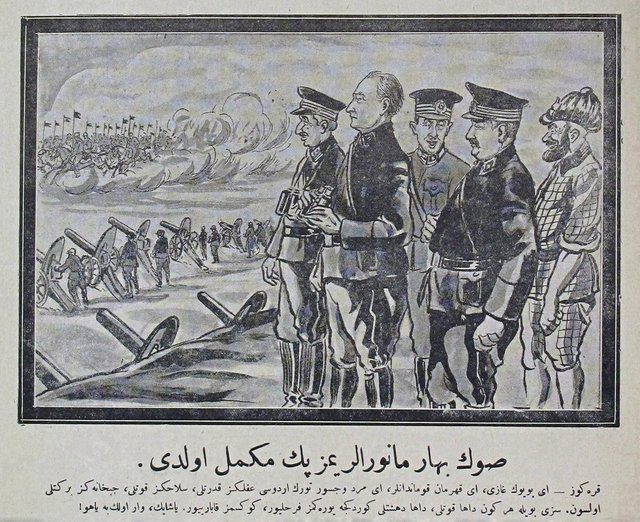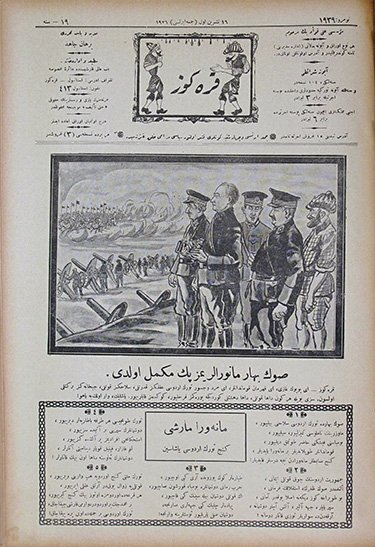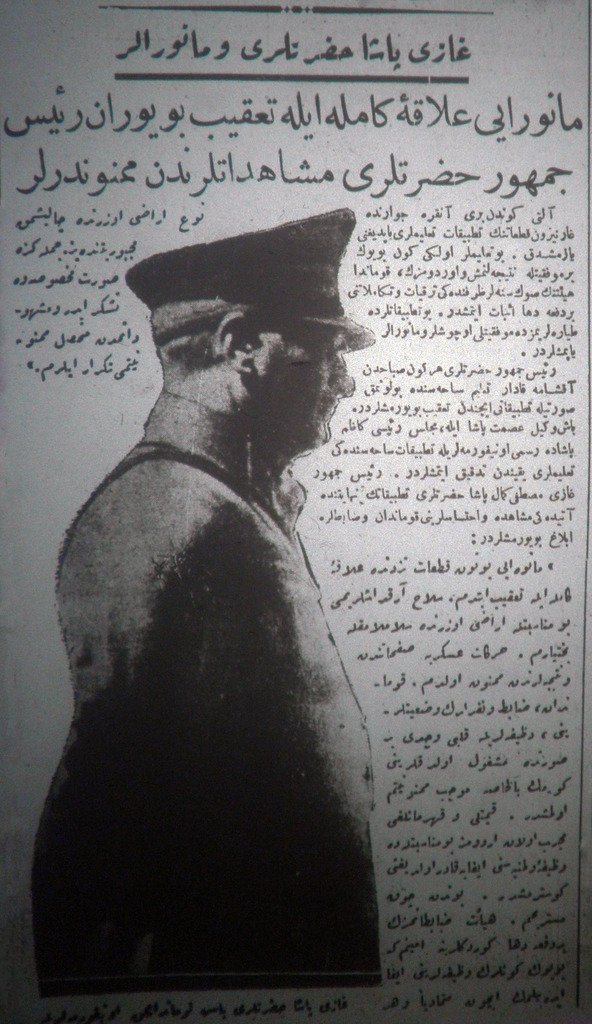118. Today in 1920s Turkey: 16 October 1926 (Inspecting the Armed Forces)

(Illustration, Karagöz, 16 October 1926, no. 1939, page 1.)
Türkçe:
Son Bahar Manevralarımız Pek Mükemmel Oldu
Karagöz: Ey büyük Gazi, ey kahraman kumandanlar, ey mert ve cesur Türk ordusu aklınız kudretli, silahınız kuvvetli, cephaneniz bereketli olsun. Sizi böyle her gün daha kuvvetli, daha dehşetli gördükçe yüreğimiz ferahlıyor, göğsümüz karabrıyor. Yaşayın, var olun be yahu!
English:
Our Autumn Maneuvers Turned Out Perfectly
Karagöz: Oh great Gazi, oh heroic commanders, oh brave and courageous Turkish army may your minds be strong, your weapons powerful, and your ammunitions abundant. Our hearts are refreshed and we swell with pride as we see you like this getting stronger, and more fearsome (with) every day. May you live long, you hear!
Comments
Featured on the front page of the 16 October 1926 issue of Karagöz, the present cartoon recreates a scene from the recent military training exercises that the state’s president and founding father Gazi Mustafa Kemal (Atatürk) attended. The image consists of five men gathered roughly in the right half of the frame overlooking the military drills unfolding in the distance, on the left half of the illustration. The practice field is dotted with rows of manned cannons in the middle ground and a flag-bearing, mounted regiment kicking up dust in the distance.
It is possible to identify most of the men in the picture with confidence. From right to left there stands Karagöz, Fevzi Çakmak, Kazım Özalp, Gazi Mustafa Kemal (Atatürk), and İsmet İnönü. Karagöz is a fictional character and mascot for his namesake newspaper, Karagöz. The relationship between Karagöz the quick-witted shadow theater character and Karagöz the magazine is akin to that of Punch the hand-puppet character (of Punch and Judy) and Punch the satirical magazine. As such, Karagöz often makes an appearance as a mediator or commentator in the illustrations of this specific magazine. This also explains why this one person’s attire does not match those worn by the other men in the picture.
Fevzi Çakmak is the next man in our lineup. He is the only other military serviceman to achieve the highest rank of Mareşal besides President Mustafa Kemal due to their superlative contributions to the Turkish War of Independence. In 1926 he was serving in the military as the 2nd Chief of General Staff.
It is the next man, Kazım Özalp’s identification that I am not completely sure about. The artist seems to have gone to great lengths to render each person with visible physical attributes connecting them to the person they are meant to represent and this man’s mustache and narrow face do not strike me as immediately recognizable. But another article (which I discuss below) claiming “The Speaker of the Parliament, Kazım Pasha (Meclis Reisi Kazım Paşa)” was in attendance supports the current identification of this person.
Fourth from the right and pictured holding a pair of binoculars is President Gazi Mustafa Kemal Pasha. He is byfar the most easily identifiable person in newspapers of the 1920s because of the frequency by which his face appears in their pages. For instance, here is a list of the Today in 1920s Turkey posts that include him as their primary or secondary subject: #15, #24, #27, #29, #91, #105, and #106. Mustafa Kemal Pasha organized and lead the aformentioned Turkish War of Independence which freed the state from Allied occupation, a transition very recently covered in this post. As a leader on the battlefield, his quickly ascended to state leadership once the war ended and a new government was established. He is depicted wearing his military uniform but his hat has been omitted, leaving him the only military man on the field with an open head. This is a small detail, but one that bugs me. Why did the artist leave Mustafa Kemal’s hat off? The best explanation I can offer is that the artist wanted this depiction to straddle both of the President’s role: civil and military. This especially holds true due to the fact that since Mustafa Kemal Pasha, referred to in the text only by his title of “Gazi,” ascended to the presidency he was often seen in very modern and fashionable civil attire. By 1926, 4 years after the war, he was rarely seen in his uniform unless it was for events such as attendance in a military drill. This duality of roles is perhaps projected through his “incomplete” uniform.
Finally, İsmet İnönü, the Gazi’s right-hand man and the Republic’s first Prime Minister is located on the far left of the group of men. After Mustafa Kemal Pasha, İnönü was one of the most frequently depicted political leaders of the 1920s.

(Entire page, Karagöz, 16 October 1926, no. 1939, page 1. Beyazit State Library, Hakkı Tarık Us Collection.)
The text accompanying this illustration reads more as a series of celebratory well-wishes for the military rather than an account of the events surrounding the Fall Drills. More details about this occasion can be found in an article published in the daily newspaper, Cumhuriyet or “Republic.” In an article from the front page of its 16 October issue (no. 876) we find out that the “maneuvers” took place around Ankara (the capital city) and lasted 6 days. The drills, which ended “a few days ago,” were attended by the President who was personally on the field “every day from morning to night.” This article also reveals that, as depicted in the cartoon, both İnönü and Kazım Pasha were in attendance “wearing their official uniforms.” A picture published alongside the article shows that the President was in fact wearing his military hat. Suggesting further that the omission of his hat in the cartoon was a creative choice taken by the artist.

(Article, Cumhuriyet or “Republic,” 16 October 1926, no. 876, page 1.)
Additional Notes: A week later Karagöz published another back-page illustration featuring Gazi inspecting the military and farms. The picture, which was the subject of its own Today in 1920s Turkey post, more overtly combined the president’s dual identities as military man and civil leader by simply conflating two separate “inspections” that he recently conducted: one on the military, and one on the state’s experimental farm. It is likely that these inspections (and their publicity) at this particular time is not coincidental. The Republic’s birthday, 29 October is fast approaching and Republic Day, from its inception, was seen as an opportunity to collate and present all of the new state’s accomplishments that have unfolded since its founding and since the last Republic Day. Scenes such as these (constructed as they may be) serve to cue the reading public into the fast approaching national milestone.